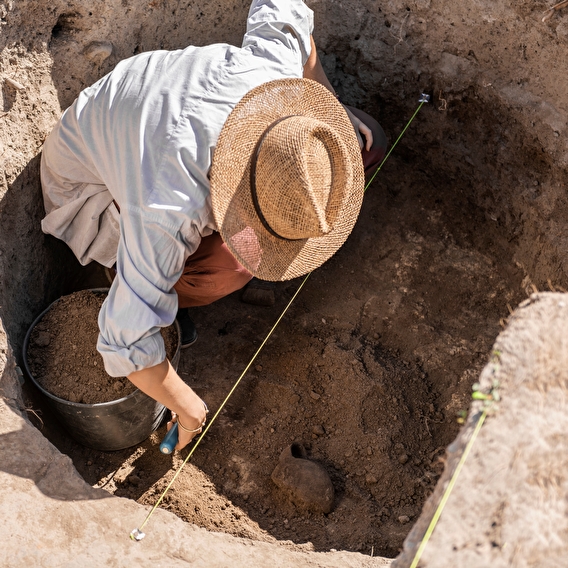BY ALAN FORSBERG, P.E., RETIRED BLUE EARTH COUNTY ENGINEER
I attended an excellent session on Archaeology and Human Remains at the January 2023 annual conference of the City Engineers Association of Minnesota. I would like to share what I learned about encountering human remains on a public works construction project.
First—it is best to avoid encountering human remains. It can result in substantial delay and significant additional costs, and may even stop or drastically revise the project.
Human remains are held in great respect by relatives and friends and may have deeply held religious value. They are also protected by state and federal laws. Protected human remains may be in a legal recorded cemetery or unofficial cemetery. Indian burial sites of all types are protected. Human remains are protected whether intact or disturbed.

State and federal laws
The relevant state law is the Minnesota Private Cemeteries Act, MS 307.08, and federal law is the Native American Graves Protection and Repatriation Act. Violation of these laws may result in felony and misdemeanor charges.
Human grave sites should be identified early in the project planning process. This can be done in several ways:
- Coordinate with state and federal agencies implementing their respective human remains laws.
- Talk to local residents, especially in rural areas. Residents may go back several generations and be familiar with recorded and unrecorded early settler and Indian burial sites.
- Review the Office of State Archaeologist (OSA) grave website and the Minnesota Indian Affairs Council (MIAC) website.
If there are known or suspected grave sites in or near your project, I would suggest hiring a consultant with the expertise and working relations with the appropriate state and federal agencies and Indian tribes to develop a plan of action and a contingency plan. Coordinating with local elected officials is also important since additional project time and funds may be needed. A formal agreement should be executed with the affected agencies, including means to avoid, minimize, and mitigate impacts to known grave sites and a contingency plan if additional grave sites are encountered during construction.
Local examples
Several examples were reviewed during the conference presentation, including Shaver Mounds on County Highway 101 in Minnetonka near Gray’s Bay and a City of Minnetonka municipal street improvement project.
The County Highway 101 project was designed to improve safety at a sharp curve with an intersecting road at the curve’s midpoint. Fifty-two earthen burial mounds were identified at this site when first surveyed in 1883. These mounds had been largely obliterated by farming and the construction of a residence. Recovery work began after construction started in May 2015 by screening loose dirt around the site. Additional human remains were found during this process. Recovery efforts resulted in a three-year project delay, redesign of the intersection to a less safe, somewhat larger curve rather than the roundabout designed and approved earlier, and a significant cost overrun.
The municipal project, which included new streets and utilities, followed an extensive project development process and considered the potential for human remains. Since known and suspected Indian burial sites were within the project area, project planning was coordinated with OSA and MIAC. A consultant with archaeological and human remains expertise was retained to help develop a formal agreement with these agencies, including a contingency plan if additional remains were discovered during construction.
Construction contract documents included provisions for dealing with any encountered human remains. The contract included “controlled boulevard stripping” to detect human remains, a monitoring plan, and provisions on action if human remains were found. There was no delay in the overall project schedule because if remains were found and work stopped in one area, work
could move to another area.
Many bones were found, but all except one were animal bones. A human bone was identified by the Tribal Monitor and confirmed by an osteologist. Work was stopped in the area of this find, and discovery was coordinated with OSA, MIAC, the county sheriff, and contractor. Additional exploration for human remains was done in the area of the find. There were additional costs in planning and construction related to the human remains process, paid by the city; however, these costs were covered by the contingency budget.
Next steps
Two questions remain with me as a former county engineer charged with serving the public health, safety, and welfare:
- Must all excavation and placement of fill be reviewed for known or suspected burials and coordinated with OSA and MIAC? Citizens may need a field entrance to harvest crops or a ditch cleaned to avoid flooding a field. These are minor activities but necessary to serve our citizens. Where is the threshold for following the human remains investigation process?
- With the increasing frequency of cremation rather than traditional burial, are scattered ashes at an informal site considered human remains? Many scattered ash sites are not recorded and are known only to an immediate relative.
Depending on the maintenance or construction project, these questions may be important to a local public works engineer. I suggest representatives from the county and city engineers’ associations, Indian Affairs Council, and state and federal cultural resources offices meet and develop guidance on them. An LRRB project could be one way to accomplish this.